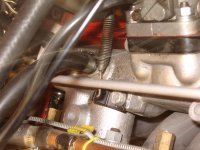An update to close out this thread. I am now sootless! Well my plugs are. Browsing around the archives I came across a post saying the plug gap should be increased by 5 thou if fitting electronic ignition. It actually says this in the Petronix FAQ website. The gaps on my NGK BP6ES are now set at .030. Problem solved.
The Colourtune still shows a yellow flame on tickover (700 Revs) but it turns Blue when I rev the engine. The plugs are now a dark chocolate colour with no soot. I'll leave it at that for now as the PO said that it likes to run a little rich. Lifting the piston pin increases the revs sightly, it's never done that before.
Thanks to all
AJ
The Colourtune still shows a yellow flame on tickover (700 Revs) but it turns Blue when I rev the engine. The plugs are now a dark chocolate colour with no soot. I'll leave it at that for now as the PO said that it likes to run a little rich. Lifting the piston pin increases the revs sightly, it's never done that before.
Thanks to all
AJ

 Hi Guest!
Hi Guest!

 smilie in place of the real @
smilie in place of the real @
 Pretty Please - add it to our Events forum(s) and add to the calendar! >>
Pretty Please - add it to our Events forum(s) and add to the calendar! >> 


